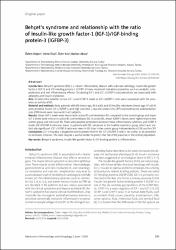| dc.contributor.author | Dogan, Ozlem | |
| dc.contributor.author | Unal, Emine | |
| dc.contributor.author | Kisa, Ucler | |
| dc.contributor.author | Aksoy, Nurkan | |
| dc.date.accessioned | 2020-06-25T18:34:31Z | |
| dc.date.available | 2020-06-25T18:34:31Z | |
| dc.date.issued | 2019 | |
| dc.identifier.citation | Doğan, Ö., Ünal, E., Kısa, Ü., & Aksoy, N. (2019). Behçet’s syndrome and relationship with the ratio of insulin-like growth factor-1 (IGF-1)/IGF-binding protein-3 (IGFBP-3). Advances in Dermatology and Allergology/Postępy Dermatologii i Alergologii, 36(3), 295-301. | en_US |
| dc.identifier.issn | 1642-395X | |
| dc.identifier.uri | https://doi.org/10.5114/ada.2019.85640 | |
| dc.identifier.uri | https://hdl.handle.net/20.500.12587/7944 | |
| dc.description | KISA, Ucler/0000-0002-8131-6810 | en_US |
| dc.description | WOS: 000472026600008 | en_US |
| dc.description.abstract | Introduction: Behcet's syndrome (BS) is a chronic inflammatory disease with unknown aetiology. Insulin-like growth factor-1 (IGF-1) and IGF-binding protein-3 (IGFBP-3) have important metabolic properties such as anabolic, cytoprotective and anti-inflammatory effects. Circulating IGF-1 and IGF-1/IGFBP-3 concentrations are associated with adiposity and insulin resistance. Aim: To determine whether serum IGF-1 and IGFBP-3 levels or IGF-1/IGFBP-3 ratio were associated with the presence or activity of BS. Material and methods: Forty patients with BS (mean age: 39.6 +/- 10), and 20 healthy volunteers (mean age: 37 +/- 10.4) were enrolled. Serum IGF-1, IGFBP-3, and high sensitive C-reactive protein (hs-CRP) and erythrocyte sedimentation rate (ESR) levels were measured in all subjects. Results: Mean IGF-1 levels were low in both active BS and remission BS compared to the control group and mean IGF-1 levels were similar in active BS and remission BS. In active BS, mean IGFBP-3 levels were higher than in the control group and remission BS. There were positive correlations between these inflammatory cytokines and IGFBP-3 levels. IGF-1/IGFBP-3 ratio was lower in patients with BS compared to the healthy volunteer group, which was statistically significant. IGF-1/IGFBP-3 ratio was lower in BS than in the control group independently of ESR and hs-CRP. Conclusions: IGF-1 may play a diagnostic role to present itself in BS. IGF-1/IGFBP-3 ratio is not useful as an activation or remission criterion. The ratio may be a useful marker to predict the risk of BS presence in the critical population. | en_US |
| dc.language.iso | eng | en_US |
| dc.publisher | Termedia Publishing House Ltd | en_US |
| dc.relation.isversionof | 10.5114/ada.2019.85640 | en_US |
| dc.rights | info:eu-repo/semantics/openAccess | en_US |
| dc.subject | Behcet's syndrome | en_US |
| dc.subject | insulin like growth factor-1 | en_US |
| dc.subject | IGF-binding protein-3 | en_US |
| dc.subject | inflammation | en_US |
| dc.title | Behcet's syndrome and relationship with the ratio of insulin-like growth factor-1 (IGF-1)/IGF-binding protein-3 (IGFBP-3) | en_US |
| dc.type | article | en_US |
| dc.contributor.department | Kırıkkale Üniversitesi | en_US |
| dc.identifier.volume | 36 | en_US |
| dc.identifier.issue | 3 | en_US |
| dc.identifier.startpage | 295 | en_US |
| dc.identifier.endpage | 301 | en_US |
| dc.relation.journal | Postepy Dermatologii I Alergologii | en_US |
| dc.relation.publicationcategory | Makale - Uluslararası Hakemli Dergi - Kurum Öğretim Elemanı | en_US |
















